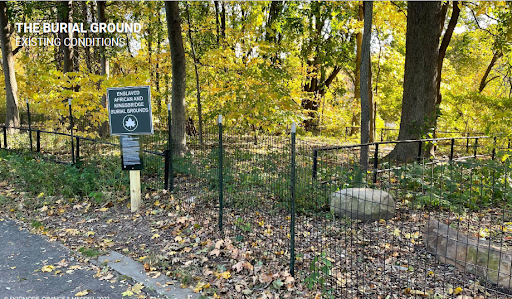African Burial Ground

Enslaved African Burial Ground
Enslaved African Legacy Tour
Located along the eastern edge of the Kingsbridge Burial Ground, this area has been identified as a burial site of enslaved Africans who lived on the Van Cortlandt family plantation. They were responsible for its functions and economic gains for over a hundred years. According to records, there were several Indigenous people who were enslaved as well.
Research is inconclusive but suggests that this area is the location where enslaved people were interred. Primary documents include wills, land deeds, census data, and estate inventories belonging to the Van Cortlandt family and other local colonial families. It was also common practice for enslaved people to be buried adjacent to the cemetery of settlers.
Slavery was outlawed in New York State in 1827; enslaved people on the Van Cortlandt estate were freed in 1821.
The adjacent Kingsbridge Burial Ground, which dates to the 17th century, was used by some of the area’s earliest colonial settlers including members of the Tippett, Berrian, Betts, Bashford, Ackerman, and Warner families. Members of the Van Cortlandt Family are buried at nearby Vault Hill.
In the 1870s, workers unearthed skeletal remains in this area while working on the construction of the New York and Northern Railroad. In 1879, a local man, Caleb van Tassel, recalled “making a coffin for a slave” who was buried here. This account was supported by J.B. James, who spent his youth around Van Cortlandt Lake, who wrote in his 1935 memoir that “a great number of skeletons of former slaves were unearthed” here during the construction of the railroad.
In 2019, NYC Parks commissioned a USDA geophysical study adjacent to the Old Putnam Trail (now the Putnam Greenway) along the former railroad lines, using ground-penetrating radar, which identified what was described as “fine linear features” that resemble coffins, 1.2 to 1.5 meters underground.
This text is part of Parks’ Historical Signs Project and can be found posted within the park.
On June 19, 2021 at a Juneteenth Ceremony, in honor of the African burial ground, located within the previously named Kingsbridge Burial Ground, a new sign bearing the words ‘Enslaved African and Kingsbridge Burial Grounds’ was unveiled.
Tour Text:
Local historians have long held that this area just outside of the Kingsbridge Burial Ground was used as a burial place for enslaved Africans. This follows a pattern seen elsewhere, in which enslaved people were interred in burial grounds adjacent to cemeteries for white colonists.
It is likely that adults were not the only ones buried here. A site study at the African burial ground in lower Manhattan revealed that nearly half of the burials were of children under 12.
No records survive, and very likely none were ever created, to document the names of the deceased or even the number of burials in this location. However, the historic Black community in Kingsbridge was about 20% of the neighborhood’s total population at its peak just after the American Revolution. It is therefore possible that there were a substantial number of burials here.
Fearing a rebellion of its enslaved population, New York’s colonial legislature banned gatherings of Black people numbering more than a few individuals. However, an exception was granted for funerals. Therefore, this spot could have been one of the few places in the area that the Black community could come together legally. This place could have carried additional meaning as the serenity of Van Cortlandt Lake is itself the legacy of enslaved Africans, who dammed Tibbetts Brook to create the lake in the early 1700’s.
In the 1870s construction workers unearthed skeletons in this area while working on the New York and Northern Railroad. According to an 1879 Yonkers Statesman newspaper article, a local man, Caleb Van Tassell, recalled “making a coffin for a slave” that was buried here. Writing in a memoir, another area resident recalled that “a great number of skeletons of former slaves were unearthed” during the railroad construction. It was not reported what happened to the skeletons after they were disinterred. The railroad trackbed later became the Putnam Greenway of today.

